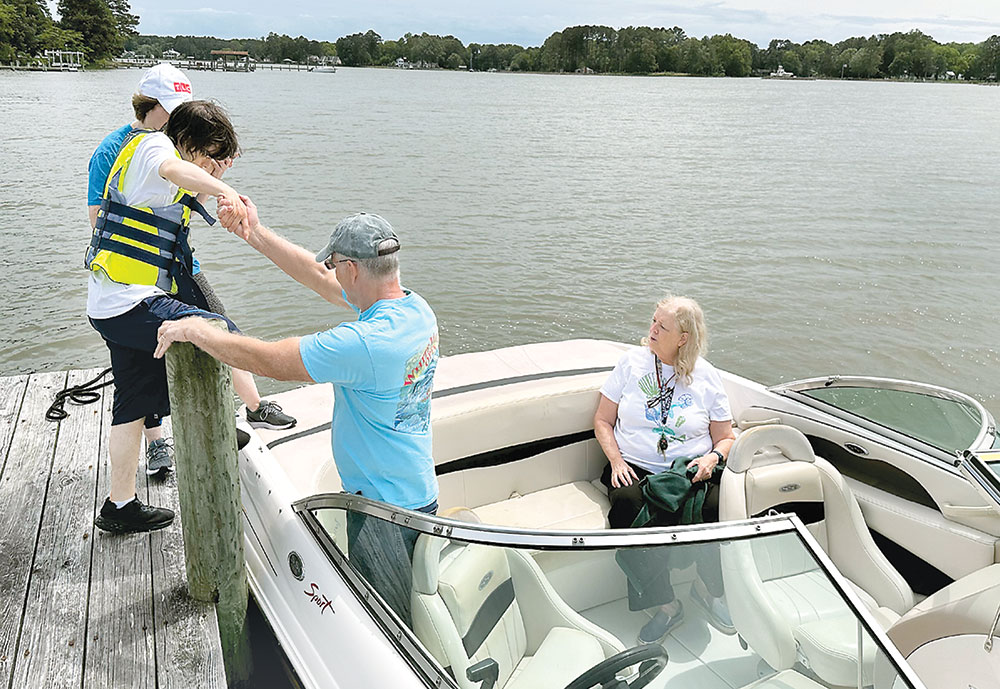
Experience is a good teacher.
Here are a few things learned the hard way in my 40 years of motor boating in a 20-foot boat. This list was compiled with the help of J.C. “Bo” Burton of Mathews, who was a Virginia Marine Resources Commission (VMRC) law enforcement officer for 19 years.
by Tom Chillemi –
“Aye Captain”
The captain is in charge. Do what he or she says. Don’t take it personally. It’s for your safety and also establishes authority for petty arguments that may come up between passengers.
The captain is the one others will look to (blame) if the boat runs aground, breaks, etc. The other half of the agreement is that the captain needs to keep everybody happy. To avoid a mutiny, let everyone drive. Stand by and let them feel the boat react to steering.
Teach them the marker colors. “Red right returning” means keep red markers on your right when going up stream towards the head waters.
Clear the deck
The deck must be kept clear because there will be times when crew has to move to adjust the angle, or attitude, of a boat. If the bow is up, weight is needed at the front. When it’s up on plane you can move back to your regular seat.
Boats and bike are opposite
A boat moves in the opposite direction it is leaning. It is the opposite of a bicycle.
This can be helpful when you’re trying to move the boat towards the dock or into a slip. You can shift the weight to one side and it will creep up over in the direction you wanted to go.
When docking and someone leans over the side to try and grab the dock lean away from the dock. Putting weight on the side away from the dock will push the boat towards the dock.
Be prepared
Approaching the dock is the time to prepare. Have a line coiled and ready to hand to someone to throw or loop around a pole.
To keep the line from getting tangled, coil the entire length then leave about eight feet slack where it attaches to the boat. Hold half the coil in each hand. Hold the coil with the “bitter end” in your throwing hand. Rotate your arm back and throw it side arm as you let go with the other hand. Don’t worry if you miss. Just be ready to coil the line and do it again. One good thing, a wet line is heavier and will travel further.
When someone throws you a line to secure a boat, the first thing you do is wrap it around a pole or something solid. This gives you leverage to hold it in place.
There is one knot that every boater should know — the clove hitch. The line is looped over the pole twice. If you’ve done it correctly, you see an X with the lines crossed.
Stay or go
If you are unsure about going for a boat ride, stay home. Captains: don’t ask anyone twice if they want to go for a boat ride. Once is enough for those who really want to go.
Don’t try to convince them that they will like it. There’s a good chance they won’t and they’ll probably put a damper on your trip wanting to go home early.
Every person added to an event complicates it.
On the water there is not a lot of stimulation. It’s a place to drift with your thoughts. If thoughts of what you “gotta” do invade, you’ll start thinking about where you should be.
This may be one reason why boating is not as popular as most people think it is; and another reason that people buy boats and then don’t use them because they really don’t know how to handle being alone.
Boating is not for everyone.
Step confidently
Don’t stop in mid-stride when boarding a boat or departing. Step in one smooth motion just like a normal step. “Newbies” will often get one foot on the boat, the other on the dock and do the splits.
Approach waves at an angle
A wake is a powerful force. A moving wave can toss a boat that weighs tons. It’s better to cross a wake quickly and perpendicular to the way the wave is moving.
Boats will only move as fast as the water will allow. A cubic yard of water weighs about 1,800 pounds. It’s a force that must be reckoned with. So if a wave is approaching the side of the boat and the boat is 10 feet long, that’s a force equal to the weight of a car.
It’s better to slice through the waves at a slight angle and don’t be in a hurry in rough seas.
When moving with the waves or into them, you will need to adjust your speed so that you’re traveling at a rate that allows you to keep control of the boat.
When moving into waves, avoid cresting one wave and then crashing into the next one.
This is no fun in a bow rider. When going into the wind you’re going to do the same thing — regulate your speed so that you’re cresting one wave then sliding down the other side at an angle. Once you become adept in reading waves, you can learn how to maneuver through the trough between them where it’s relatively smooth. Again, you must adjust your speed and work with the water, not against it.
If you wear glasses a retaining strip is a good idea. If your hat blows off while under way it’s a good time for a man overboard drill. One person should do nothing but look at the hat in the water. The boat should approach slowly downwind of the object so the wind doesn’t blow the boat into the thing or person to be rescued.
Docking is an art
Approach the dock with the boat in neutral and see which direction the wind or tide will move it. Always dock into the wind — otherwise the wind will push you around. The idea is to use the wind as a stabilizing force.
Chuck Yeager, the famous aircraft test pilot, had a saying. To paraphrase, he said that any landing you could walk away from was a good landing and if the aircraft could be used the next day it was a spectacular landing.
This is a reasonable assumption for docking. The main thing is you don’t want to hit anything solid hard enough to harm the passengers.
On the beach
When beaching be aware of the tide. If it’s going out, the boat could be left on the beach.
Two anchors are a good way to avoid this. One smaller anchor is let out as you approach land and it keeps the boat from moving up on the beach, and the bow anchor keeps it steady.
Watch out
Crab pot buoys are to be avoided. If you know the wind and the tide, you can figure the buoy is downwind of the crab pot. The line is usually laden with marine growth which causes them to sink so they usually go straight down. Some crabbers put a float on the line close to the buoy because it makes them easier to pick up, but the float is not the norm.
Best of times
One of the best times to go boating is in the evening a few days before the full moon, this is because when the sun goes down the moon is already up and it’s bright. The full moon never sees the setting sun. You can time your trip so that you are returning in the moonlight, which will be reflecting off the water.
Steady
Loading a boat on a trailer isn’t easy. If you can, it’s a good idea to have the driver of the tow vehicle remain in the vehicle during the operation. It’s something learned from experience.
“The best life jacket is the one you will wear.”
Life jackets save lives.
Some think, “I can swim, I don’t need a lifejacket.” Sure, they can swim in a pool, with flat water, maybe for 100 yards. How long can they tread water?
And, what happens if they are incapacitated?
Not many want to wear the bulky, old-fashioned life jacket. Inflatable life jackets have been around for 25 years. Some inflate automatically when contacting water. Others must be activated. The BOAT US magazine for June and July has an extensive summary of inflatable life jacket options.
“The best life jacket is the one you will wear,” says the National Safe Boating Council.
We have used the “belt pack” life jacket for years. While not the top choice, we reasoned that if we fall in the water, at least we’ll have something with us. The user has to pull a cord to inflate it, then slip it over their head.
It’s so comfortable that more than once I’ve worn it off the boat and not realized I had it on.
Paddlers — getting back into a kayak in the water is hard to do. It’s something that should be practiced. Of course, wear a life jacket.


